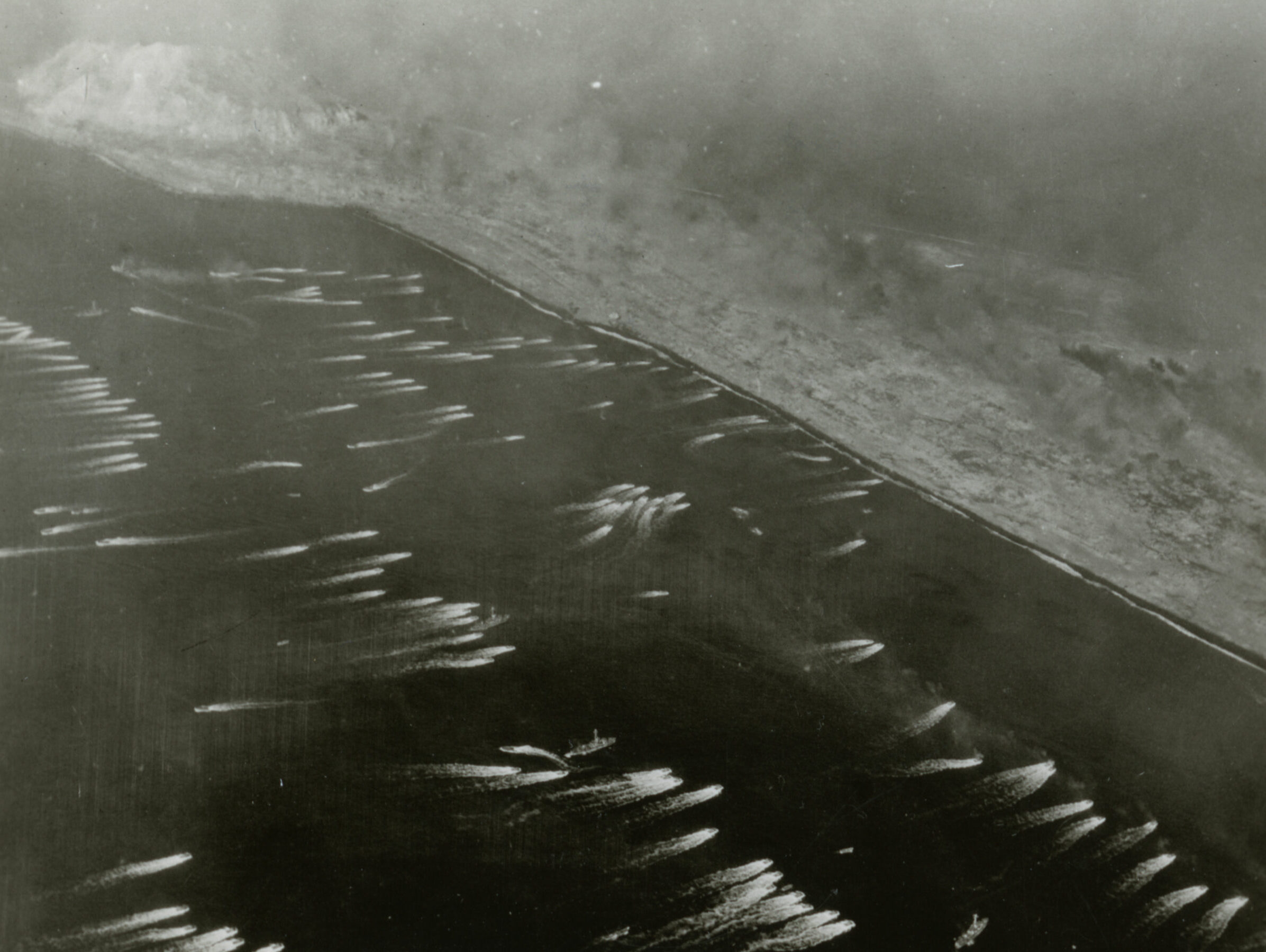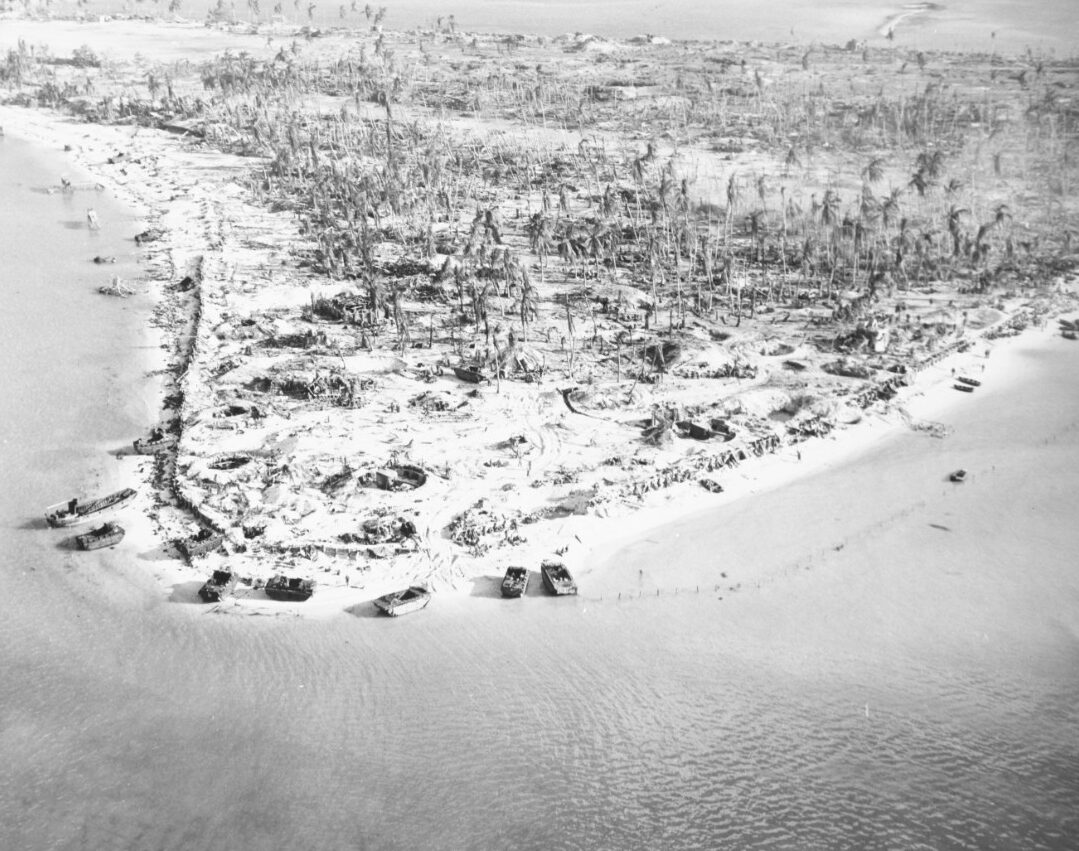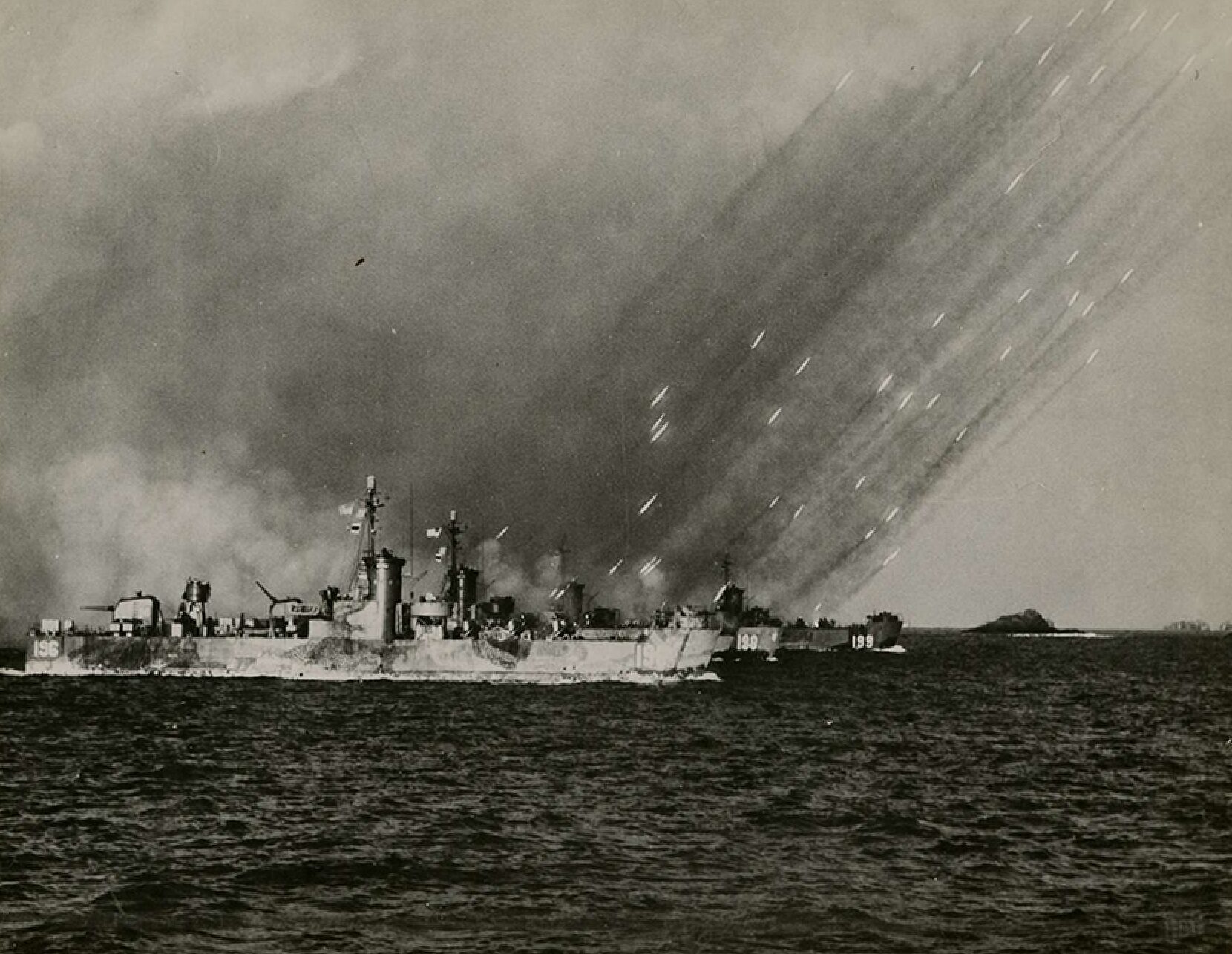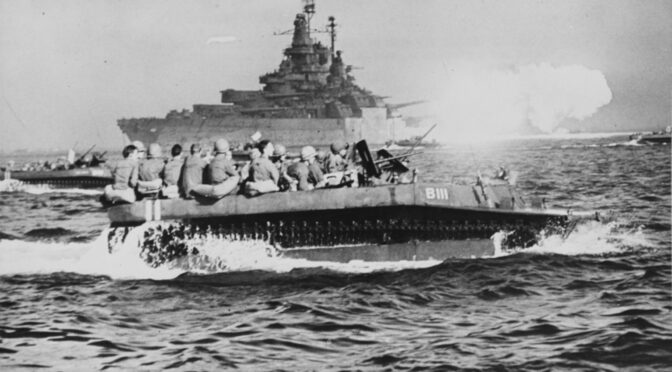By Dmitry Filipoff
Chris Hemler spoke with CIMSEC to discuss his book, Delivering Destruction: American Firepower and Amphibious Assault from Tarawa to Iwo Jima. In this book, Hemler examines the development of American amphibious fire support doctrine during WWII and offers insightful analysis on wartime organizational learning.
In this discussion, Hemler discusses the challenges of developing combined arms warfighting doctrine, key organizational constructs that facilitated flexible command-and-control of amphibious fire support, and the fundamental principles that fostered adaptation in war.
Why investigate this topic and publish a book on it?
The short answer is that I have always been fascinated by the Pacific War – the naval character of the conflict, the great distances involved, the incredible industrial production required, and many more captivating themes. In addition, my operational experience in the U.S. Marine Corps has given me a firsthand perspective on the difficulties and obstacles involved in amphibious operations. So when I combined my interests, my curiosity, and my experiences with a story that I felt was missing from the World War II scholarship, I had my project.
What role did triphibious fire support play in the American operational approach in the Pacific War?
First, maybe a note on semantics. I stumbled into the word “triphibious” during my research, and I’ll be honest, it wasn’t love at first sight. But over time, the word grew on me. And before long, it took on a dominant role in my project and eventually my book. It is an important word that allows us to look at the Pacific War with a different lens and it is the single most important word in Delivering Destruction. In order to seize the hardened islands of the Central and Western Pacific, American forces had to master triphibious fire support. And I think that is a very important storyline to cover when we discuss the war.
Triphibious fire support – the combined application of heavy firepower delivered by air, land, and sea to support amphibious invasion – was essential. It was an indispensable function for Nimitz’s Central Pacific campaign. While the ground units, air support, and naval gunfire elements have all received individual recognition before, it was truly the combination – the synergy – of these various capabilities that allowed the Americans to advance at the rate they did and triumph in the way they did. Triphibious fire support, and namely the combined arms coordination and integration of that support, was an essential ingredient of success in the Pacific War.
The traditional historiography of the war, and indeed the films and television series that cover the war, do an excellent job acknowledging the infantrymen, artillerymen, naval aviators, and others that enabled victory against Japan. But often lost in that narrative – a narrative typically defined by individual warfare communities and individual skills – is the synergy of those various communities. And that’s the storyline that Delivering Destruction provides.

You discuss the triphibious doctrinal innovation that occurred during the interwar period, and how it fell far short of what was needed in wartime. Why did the fleet exercises and doctrinal development of the interwar period not deliver an effective triphibious fire support system in time for the war?
That is a really important question, and one that I have taken very seriously in my work. I don’t want to be unfairly critical of the interwar Navy and Marine Corps, but it is essential that we learn from the success and the shortfalls of the interwar period. And while the interwar triumphs are well-cataloged, the failures are much less acknowledged. While the naval services spent a great deal of time and attention addressing their concerns over landing craft, logistics, and other amphibious matters, they did not dedicate sufficient attention to the coordination of triphibious firepower. Therefore they did not appreciate the full complexity and difficulty of the challenge they faced.
Planners of the 1920s and 30s thought an awful lot about how to get to the beach, but they did not adequately address staying on the beach. They did not acknowledge the firepower requirements, careful coordination, and mature tactics that would spell success. This left the interwar Fleet Landing Exercises (FLEXs) entirely unrealistic in the coordination and delivery of firepower. To preserve the safety of their troops, most landing forces trained on separate islands from the naval gunfire ships. Umpires used wooden targets ashore to represent enemy bunkers, and naval gunfire officers confirmed their misplaced confidence in “area bombing” methods, which were replaced by more rigorous precision bombing techniques developed during the war. These artificialities led one Marine pilot to label his FLEX as “little more realistic than a map problem.”
Some servicemembers did voice concerns, but they formed only a minority opinion, and their critique had little effect. The result left American naval forces unprepared for the full task that lay before them – effectively integrating and coordinating not only distinct forces, but distinct forms of firepower, during a contested seaborne assault.
Why was the triphibious experience at Tarawa so challenging yet so instructive?
Prior “ignorance” is one explanation. That is the word the accomplished naval historian Samuel Eliot Morison used in his study of the Tarawa attack. To be certain, the Marines knew that Betio Island, the Japanese stronghold of the atoll, was very well-defended. Japanese troops had more than 500 concrete bunkers and a frightening web of mines, barbed wire, and machine gun and mortar positions.
That intelligence aside, the Marines were quite confident as they rode ashore. Unchallenged confidence in the naval gun reigned supreme. The Americans’ three-hour naval bombardment prior to the landing was a stunning display. Three battleships, four heavy cruisers, and nearly two dozen destroyers delivered ordnance ranging in caliber from three inches to fourteen inches. As one admiral briefed his peers before the battle, “Gentlemen, we will not neutralize Betio Island. We will not destroy it. We will obliterate it.” Needless to say, that was far from what transpired, as Tarawa turned out to be a brutal experience for the Marines despite the preparatory bombardment.

Those hard experiences became cherished lessons that the U.S. Navy and Marine Corps integrated into their planning and preparation for the remainder of the war. Just as Guadalcanal had introduced them to the zeal and determination of their Japanese enemy, so Tarawa introduced them to the full challenge of the amphibious assault. By noting and then addressing their impractically rigid fire support timelines, unsuited communications gear, and deficiencies in coordination at the beachhead, it was the American response to the trauma of Tarawa that proved crucial to the subsequent campaigns of the war.
How would you describe the system of operational learning and the various feedback loops that matured this capability? How did they process lessons from major battles, anticipate challenges, and incorporate new doctrine and training into the force in the leadup to future battles?
In this case, the answer is twofold. Bottom-up adaptation drove much of the Americans’ progress throughout the war. In the book, I mention the names and post-battle efforts of junior and mid-level officers that are, almost exclusively, missing from the war’s narrative. These were the leaders on the front lines observing operations in real time, analyzing the Americans’ performance, and delivering professional critique to improve upon their methods. They constantly iterated on firing techniques, ship positioning, communications, and cross-unit culture. Men like Navy Lieutenant Charles Corben, Marine Lieutenant Colonel Donald Weller, and Marine Colonel Vernon Megee are not household names, but their contributions compel recognition. These men belong to Paul Kennedy’s “engineers of victory” – the individuals that fostered critical change and adaptation at the working level in wartime.
But it wasn’t all grassroots adaptation. The V Amphibious Corps also exercised a healthy dose of bureaucracy in the form of patient and persistent administrative work. Following each individual campaign, staff representatives produced after-action tomes averaging more than 1,000 pages. After the battle for Iwo Jima, their report ran to an astonishing 1,600 pages. In these organizational reflections, the V Corps commented on everything from manning arrangements to communications to ammunition projections. Coupled with the ad hoc evolution of their units and more junior leaders, these efforts fed a continuous feedback loop that helped the Navy and Marines improve at each and every juncture.
You trace the development of the JASCO coordination teams that were central to managing triphibious fires. What role did these specialized teams serve and how did they evolve throughout the war?
They JASCOs were critical to the Americans’ ability to seize – and more importantly hold – a defended beach. The Joint Assault Signal Company construct emerged in late 1943, fueled in part by the costly lessons of the attack on Tarawa. They were designed to bring the disparate components of the task force together, help blend the distinct cultures of the triphibious arms, and provide an administrative headquarters for the fielding, training, planning, and integration of fire support.
By virtue of their mandate, the JASCOs became the most important actor in both managing and improving triphibious fires throughout the war. Over time – and through proven battlefield performances – they built a remarkable reputation. They embedded themselves within the landing forces they served, and they also built strong relationships with other representatives of the naval task force, often through personal liaison, shipboard conferences, and enduring relationships. The JASCOs matured from “suspicious stranger” in the early days of the war to a trusted teammate by 1945. They became the human network and organizational construct that enabled effective fire support across the V Amphibious Corps.
The development of this capability was hampered by differences in culture and operating practices, including between communities and between services. What differences had to be managed to mature these combined arms teams and capabilities?
American forces had to overcome several cultural hurdles in order to achieve their fullest potential as a naval combined arms force in the Pacific. Many of these hurdles flowed not from willful obstinance, but from divergent understandings and perspectives on operational priorities, risk tolerance, and more. In most cases, U.S. Sailors and Marines were not trying to thwart coordination, but their distinct assumptions and tactical concerns occasionally clashed, thereby splintering the cohesion and combat effectiveness of the force.
Throughout the interwar years, and into the early campaigns of the conflict, many senior Navy officers remained opposed to amphibious warfare, in spirit if not in word. From their perspective, any prioritization of or preference for amphibious operations compromised the proper identity of the fleet, anchored in conventional surface forces and decisive engagements at sea. Furthermore, the mobility constraints of supporting a landing force in a particular place for an extended period invited foolish risk upon the naval task force, which prided itself on constant mobility.
Troops encountered cultural friction at the tactical level as well. In the Gilbert and Marshall Islands offensives, American aviators encouraged their counterparts on the ground to accord greater respect to prearranged timelines and support agreements. In a pilot’s mind, the timeline was supreme. From their earliest indoctrination in aviation culture, pilots were directed to monitor precise metrics such as launch schedules, altitude readings, and fuel levels that yielded timelines for aviation operations. Such precise data dictated the support that a naval pilot could provide to the infantrymen below.
On the other hand, the ground units making their way ashore against tides, headwinds, and problematic coral reefs – to say nothing of the enemy forces firing projectiles at them – were taught to anticipate chaos and uncertainty. Valuing flexibility, adaptability, and resourcefulness, the culture of the landing force provided a stark contrast to the aviator’s preference for methodical action.
The story of the V Amphibious Corps in the Central Pacific is very much a story of these cultures learning to coexist. And learning to not only acknowledge but appreciate the values and perspectives of adjacent units and communities. Neither tribe was incorrect. The real-time application of triphibious fires required aspects of both mindsets, according to the circumstances, requirements, and resources at hand. Only in the tailored combination of these cultures and of these fires did the V Amphibious Corps find ultimate victory.

Triphibious fire support consists of the fires delivered by naval and air forces, as well as the organic artillery of the amphibious landing force. How do these different types of fires and delivery systems cover each other’s weaknesses and form a combined arms system?
Delivering Destruction is not meant to be a highly technical study nor a deep comparison of the nuances inherent to each delivery system. But without a doubt, the book introduces the reader to the general capabilities and constraints of the various platforms and the synergy they create when employed together.
The campaigns of the Central Pacific certainly revealed the complementary strengths and weaknesses of naval, air, and field artillery fires. Naval gunfire provided consistent and sustained coverage during landing operations, and its capacity for high-volume fire support made it the backbone of the Americans’ island assaults. In particular, as naval gunfire officers learned from and improved upon their early experiences in the Gilbert and Marshall Islands, naval gunfire ships positioned themselves closer and closer to shore in order to provide the most precise and destructive fires possible to the forces fighting ashore. This is how the admiral and naval gunfire advocate Richard “Close-In” Conolly got his fantastic nickname.
For their part, American aviators provided a more mobile platform capable of striking much deeper into enemy territory. Although most of the V Corps’ objectives were not large enough to make distance a significant consideration, air support proved particularly valuable against reverse-slope targets, which often presented a challenge for naval gunners (from the attacker’s perspective, reverse-slope targets lay on the far slope of a hill or mountain, making them more difficult both to identify and strike).
Environmental conditions presented different challenges to air and naval forces, meaning that one or the other might enjoy a particular advantage on a particular day. While aircraft could be grounded on account of visibility or cloud cover, ships were most often disrupted by poor sea states driven by wave activity, swells, and wind. In general, naval gunfire proved much more resilient in the face of poor weather, but performance could be more nuanced according to the local conditions of a specific location or operation.
Field artillery provided yet its own combination of strengths and weaknesses, whereby it could provide sustained, high-tempo fire support so long as its ammunition allowed. Mobility was certainly more challenging for the field artillerymen, especially in the constrained beacheads of most Pacific War battles, where maneuver space was limited and terrain often problematic.
You point to how triphibious fire support was fundamentally a human endeavor, something that could not be mastered through a formulaic approach alone. How was the human element critical for maturing this capability, and how should formulaic aspects compliment the human element?
The technology and the mathematics have to work, they are essential. Shell-fuze combinations, aircraft payloads, and firing solutions are all critical matters. And they are quite scientific. But those formulaic aspects must provide for tailored application and adaptation to the battlefield of human combat that is inherently marked by uncertainty, disorder, and friction. The battle is far from over just because you mastered your math homework. In combined arms, formulas are necessary but insufficient.
The human teamwork and artful execution behind triphibious firepower was decisive in the Pacific. The way that U.S. Sailors and Marines brought these capabilities together, experimented and iterated on new tactics from 1943 to 1945, and combined their weapons and their expertise to achieve creative solutions on the battlefield was quite remarkable. The evolution of air support control and authority during the war, the amalgamation of service branch cultures and priorities over three years, and the careful synchronization of a “rolling” naval barrage during the assault on Iwo Jima are but a few examples of the creative firepower achievements in the war. And those achievements point to the primacy of the human, not the scientific, element.

How could these lessons apply to the main contingency many are considering today, a Taiwan invasion? Both in terms of the joint fires that could support the invasion, and those that could stop it?
I am far from an expert on emerging weapon systems or the potential scenarios in the Western Pacific today. But what I can reflect on are a few principles that helped the V Amphibious Corps fight its way across the Pacific in the 1940s. And these principles are not just fire support principles – I am convinced they are fundamental principles of collaboration. Whether military units or civilian organizations, joint service operations or multinational alliances, island assaults or shipbuilding challenges, these are principles that help divergent groups come together to solve complex, high-stakes problems:
Nothing teaches like experience. The Navy and Marine Corps made laudable progress during the interwar period. They experimented with important concepts and advanced several important platforms that would play a role in their success against Japan. But in the realm of supporting arms coordination, their theories were proven incomplete. Their training scenarios left much to be desired. Namely, they failed to interrogate their firepower integration efforts, the communication networks that would allow for success, and the troops that would bring aerial, naval, and ground-based fires together. Part failure of imagination and part insufficient self-critique, the Americans began the war with confident theories but little practical experience. Interwar shadow boxing didn’t do the trick, and the opening bouts of the war laid bare the United States’ deficiencies. In the case of triphibious firepower, nothing taught like actual experience.
Awareness feeds decision-making. Arguably the greatest contribution that the Joint Assault Signal Companies (JASCOs) made to the success of the V Amphibious Corps was an increased awareness of the battlefield throughout the assault. By connecting front-line spotters, offshore gunners, overhead pilots, and battlefield commanders (read, decision-makers), the JASCOs delivered unprecedented awareness to American forces. This awareness allowed staff officers and commanders to make informed judgments in real time and refine their command-and-control. It allowed them to triage the most pressing situations in the battle. This awareness then allowed commanders to apply the most appropriate (or most available) fire support solution to the given situation. Great leaders – and great teams – must have a strong sense of awareness throughout their environment, whether that’s a battlefield, a basketball court, or a dynamic industry.
Familiarity strengthens outcomes. Over time, the awareness that helped to shape better targeting in triphibious fire support also increased the familiarity and shared knowledge between the specialized troops of the V Corps. And that familiarity bred a stronger fire support cycle from start to finish. As infantrymen gained a better understanding of the capabilities and limitations of naval gunfire support or close air support, they became more informed users of that firepower. They learned which targets, terrain, distances, and conditions made for a better (or worse) fire support mission. Through the same shared experiences, naval officers, pilots, and artillerymen increased their familiarity with infantry tactics, needs, and challenges. As the V Corps troops evolved in their understanding of and appreciation for their fellow troops – whoever they were – the team got better.
Redundancy is essential. This combined arms principle is ancient, but that makes it no less critical. Improving the efficiency and integration of triphibious firepower allowed the V Corps to build organic redundancy into its firepower solutions. No matter the circumstantial challenges –enemy reinforcements, hardened positions, defenses-in-depth, coral reef impediments, problematic weather – the Americans had not only sufficient but redundant fires. If an artilleryman could not reach a target, then a pilot could. And that translated to a tremendous advantage for the Americans, particularly by late 1944 and 1945. Redundant fire support could overcome a variety of mistakes or weaknesses on the battlefield, just as redundant skills and effective cross-training can help any team through a tough season or unanticipated challenge.
It is through these principles that triphibious fire support matured and eventually contributed to ultimate victory in the Pacific.
Dr. Chris Hemler spent ten years on active duty in the U.S. Marine Corps, holding posts with the 24th Marine Expeditionary Unit, 2d Marine Aircraft Wing, and U.S. Naval Academy Marine Detachment. He holds a PhD in military history from Texas A&M University and is the author of Delivering Destruction: American Firepower and Amphibious Assault from Tarawa to Iwo Jima(Naval Institute Press, 2023). Chris currently serves as a Professor of Naval Studies at the U.S. Naval Community College and a Marine reservist with the Marine Corps History Division. He resides in Annapolis, Maryland with his wife and two children.
Dmitry Filipoff is CIMSEC’s Director of Online Content. Contact him at Content@Cimsec.org.
Featured Image: April 1, 1945 – The battleship USS Tennessee b

